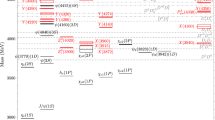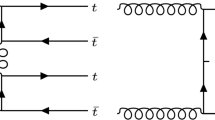Abstract
Almost all branching ratios and longitudinal polarization fractions of the double charm decays \(B_{(s)} \to D_{(s)}^{(*)} D_{s}^{(*)}\) have been measured, and the experimental central value of \(f_{L}({B^{0}_{s}}\to D^{*+}_{s}D^{*-}_{s})\) is quite small comparing to its Standard Model prediction. We study the fourth generation quark contributions to the double charm decays \(B_{(s)} \to D_{(s)}^{(*)} D_{s}^{(*)}\). We find that the loop diagrams involving the fourth generation quark t′ have great effects on all branching ratios and CP asymmetries, which are very sensitive to the fourth generation parameter \(\lambda ^{s}_{t^{\prime }}\) and \(\phi _{t^{\prime }}\). Nevertheless, the experimental measurements of all branching ratios can not give effective constraints on relevant new physics parameters. In addition, they have no obvious effect on the relevant polarization fractions. These results could be used to search for the fourth heavy quark t′ via its indirect manifestations in loop diagrams.






Similar content being viewed by others
References
Aaij, R., et al.: LHCb Collaboration. Phys. Rev. D 87, 092007 (2013). arXiv:1302.5854[hep-ex]
Aaltonen, T., et al.: CDF Collaboration. Phys. Rev. Lett. 108, 201801 (2012). arXiv:1204.0536[hep-ex]
Esen, S, et al.: Belle Collaboration. Phys. Rev. D 87, 031101 (2013). arXiv:1208.0323
Aubert, B., et al.: BABAR Collaboration. Phys. Rev. D 74, 031103 (2006). arXiv:hep-ex/0605036
Aubert, B., et al.: BABAR Collaboration. Phys. Rev. D 71, 091104 (2005). arXiv:hep-ex/0502041
Aubert, B, et al.: BABAR Collaboration. Phys. Rev. D 67, 092003 (2003). arXiv:hep-ex/0302015
Ahmed, S., et al.: CLEO Collaboration. Phys. Rev. D 62, 112003 (2000). arXiv:hep-ex/0008015
Gibaut, D., et al.: CLEO Collaboration. Phys. Rev. D 53, 4734 (1996)
Albrecht, H., et al.: ARGUS Collaboration. Z. Phys. C 54, 1 (1992)
Bortoletto, D., et al.: Phys. Rev. Lett. 64, 2117 (1990)
Hou, W.S., Soni, A., Steger, H.: Phys. Lett. B 192, 441 (1987)
Hamzaoui, C., Sanda, A.I., Soni, A.: Nucl. Phys. Proc. Suppl. 13, 494 (1990)
Eilam, G., Hewett, J.L., Rizzo, T.G.: Phys. Rev. D 34, 2773 (1986)
Vysotsky, M.I.: arXiv:1312.0474[hep-ph]
Geller, M., Bar-Shalom, S., Eilam, G., Soni, A.: Phys. Rev. D 86, 115008 (2012). arXiv:1209.4081[hep-ph]
Burdman, G., Haluch, C.E.F.: JHEP 1112, 038 (2011). arXiv:1109.3914[hep-ph]
Chen, N., He, H.J.: JHEP 1204, 062 (2012). arXiv:1202.3072[hep-ph]
He, X.G., Valencia, G.: Phys. Lett. B 707, 381 (2014). arXiv:1108.0222[hep-ph]
Bar-Shalom, S., Nandi, S., Soni, A.: Phys. Rev. D 84, 053009 (2011). arXiv:1105.6095[hep-ph]
Banerjee, S., Frank, M., Rai, S.K.: Phys. Rev. D 89, 075005 (2014). arXiv:1312.4249[hep-ph]
Jung, M., Schacht, S.: Phys. Rev. D 91, 034027 (2015). arXiv:1410.8396[hep-ph]
Mohanta, R.: Phys. Rev. D 84, 014019 (2011). arXiv:1104.4739[hep-ph]
Fleischer, R.: Eur. Phys. J. C 51, 849 (2007). arXiv:0705.4421[hep-ph]
Li, R.H., Wang, X.X., Sanda, A.I., Lu, C.D.: Phys. Rev. D 81, 034006 (2010). arXiv:0910.1424[hep-ph]
Faller, S., Fleischer, R., Mannel, T.: Phys. Rev. D 79, 014005 (2009). arXiv:0810.4248[hep-ph]
Soni, A., Alok, A.K., Giri, A., Mohanta, R., Nandi, S.: Phys. Rev. D 82, 033009 (2010). arXiv:1002.0595[hep-ph]
Buchalla, G., Buras, A.J., Lautenbacher, M.E.: Rev. Mod. Phys. 68, 1125 (1996). arXiv:hep-ph/9512380
Wirbel, M., Stech, B., Bauer, M.: Z. Phys. C 29, 637 (1985)
Bauer, M., Stech, B., Wirbel, M.: Z. Phys. C 34, 103 (1987)
Kim, C.S., Wang, R.M., Yang, Y.D.: Phys. Rev. D 79, 055004 (2009). arXiv:0812.4136[hep-ph]
Gronau, M.: Phys. Lett. B 233, 479 (1989)
Soto, J.: Nucl. Phys. B 316, 141 (1989)
Ali, A., Kramer, G., Lu, C.D.: Phys. Rev. D 59, 014005 (1998). arXiv:hep-ph/9805403
Palmer, W.F., Wu, Y.L.: Phys. Lett. B 350, 245 (1995). arXiv:hep-ph/9501295
Olive, K.A, et al.: Particle data group. Chin. Phys. C 38, 090001 (2014)
Lucha, W., Melikhov, D., Simula, S.: Phys. Lett. B 701, 82 (2011). arXiv:1101.5986[hep-ph]
Lucha, W., Melikhov, D., Simula, S.: Phys. Lett. B 735, 12 (2014). arXiv:1404.0293[hep-ph]
Li, Y., Lu, C.D., Xiao, Z.J.: J. Phys. G 31, 273 (2005). arXiv:hep-ph/0308243
Caprini, I., Lellouch, L., Neubert, M.: Nucl. Phys. B 530, 153 (1998). arXiv:hep-ph/9712417
Falk, A.F., Neubert, M.: Phys. Rev. D 47, 2965 (1993). arXiv:hep-ph/9209268
Neubert, M., Rieckert, V.: Nucl. Phys. B 382, 97 (1992)
Neubert, M.: Phys. Rev. D 46, 2212 (1992)
Cheng, H.Y., Chua, C.K., Hwang, C.W.: Phys. Rev. D 69, 074025 (2004). arXiv:hep-ph/0310359
de Divitiis, G.M, Petronzio, R., Tantalo, N.: JHEP 0710, 062 (2007). arXiv:0707.0587[hep-lat]
Amhis, Y., et al.: Heavy Flavor Averaging Group Collaboration, arXiv:1207.1158[hep-ex]
Fajfer, S., Kamenik, J.F., Nisandzic, I.: Phys. Rev. D 85, 094025 (2012). arXiv:1203.2654[hep-ph]
Falk, A.F., Neubert, M.: Phys. Rev. D 47, 2982 (1993). arXiv:hep-ph/9209269
Acknowledgments
The work of Yuan-Guo Xu was supported by Joint Funds of the National Natural Science Foundation of China (No. U1204113). The work of Ru-Min Wang was supported by Program for the New Century Excellent Talents in University (No. NCET-12-0698).
Author information
Authors and Affiliations
Corresponding author
Appendices
Appendix A: FF1
The form factors calculated in the framework of Heavy Quark Effective Theory [39, 40].
The form factors of B → D transition are [40]
with \(R_{D^{(*)}}=2\sqrt {m_{B}m_{D^{(*)}}}/(m_{B}+m_{D^{(*)}})\), \(r=m_{D^{(*)}}/m_{B}\) and \(\omega =({m_{B}^{2}}+m_{D^{(*)}}^{2}-q^{2})/(2m_{B}m_{D^{(*)}})\), therefore, we take Δ(ω) = 0.46 ± 0.02 [44], and
with \(z(\omega ) = (\sqrt {\omega +1}-\sqrt {2})/(\sqrt {\omega +1}+\sqrt {2})\) [39] and \({\rho _{1}^{2}}=1.186\pm 0.055\) [45].
The form factors of B → D ∗ transition are [39]
with
For the free parameters, we take \(h_{A_{1}}(1)|V_{cb}|=(35.90\pm 0.45)\times 10^{-3}\), ρ 2=1.207±0.026, R 1(1) = 1.403±0.033 and R 2(1) = 0.854±0.020 from [45], in addition, R 3(1) = 0.97±0.10 taken from [46] and \(R_{0}(1) = \frac {[R_{3}(1)(1-r)^{2}-R_{2}(1)(1-r)]/r+2}{(1+r)}\) taken from the HQET prediction for the linear combination [40, 42, 47].
Appendix B: FF2
The form factors which include perturbative QCD corrections induced by hard gluon vertex corrections of b → c transitions and power corrections in orders of 1/m b, c [41, 42].
with
where Isgur-Wise function ξ(x) = 1−1.22(x−1)+0.85(x−1)2 taken from Ref. [43], in addition, \(\hat {C}_{i}\), ρ i (x) and \(\bar {\Lambda }\) can be found in Ref. [41].
Rights and permissions
About this article
Cite this article
Xu, YG., Wang, RM. Studying the Fourth Generation Quark Contributions to the Double Charm Decays \(B_{(s)} \to D_{(s)}^{(*)} D_{s}^{(*)}\) . Int J Theor Phys 55, 5290–5306 (2016). https://doi.org/10.1007/s10773-016-3149-x
Received:
Accepted:
Published:
Issue Date:
DOI: https://doi.org/10.1007/s10773-016-3149-x




